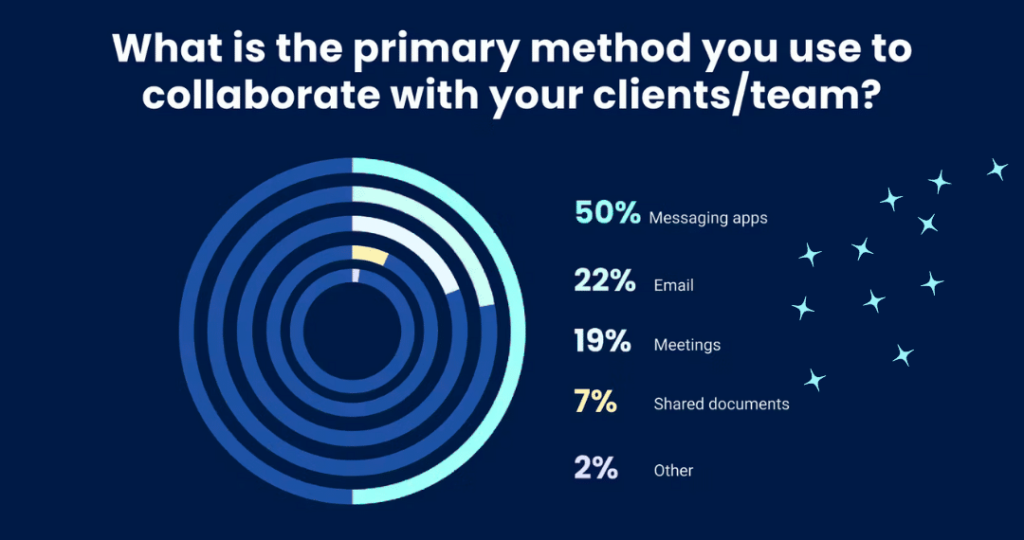Written by

Sina Brust
#virtualspacehero
The ongoing transformation of the workplace into a virtual environment necessitates an equally swift evolution in how we communicate. In one of our recent workshops on Effective Virtual Communication, we highlighted this development, sparking a conversation among students and professionals alike.
The Role of Effective Virtual Communication in Enhancing Team Performance
The digital era has brought its own set of challenges for virtual teams, including unstable internet connections, camera shyness, the complexity of scheduling across time zones, the daunting task of ensuring cohesive team dynamics, and even more to be found in the picture below. But there is one universal truth for teams independent of whether you are working on-site, virtual, or hybrid: the bedrock of any successful team is clear, concise communication coupled with mutual understanding and respect for each other’s contributions.
What Makes a Virtual Team Stand Out?
An outstanding virtual team is characterized by a shared vision, clearly defined roles, and an unambiguous communication strategy—all within a psychologically safe environment that fosters openness and alignment with the organization’s broader goals. It’s not just about having the right tools; it’s about creating a culture where every team member feels valued and understood.
The Individual’s Role in a Virtual Team
We explored several tools in our workshop and want to introduce them to you here now
1️⃣ The Personal User Manual
This is a tool for introspection and transparency. Understanding your communication style, work preferences, and boundaries is critical. By sharing this manual with your team, you invite them to reflect on their own strengths, needs and be self-aware – and thereby fostering a deeper level of collaboration.
2️⃣ Team Agreements
Only 19% use meetings as a primary method to collaborate? As can be seen in the picture above, the chosen tools to work with can vary and should be discussed with your team. The foundation of effective teamwork lies in establishing clear team agreements. These cover everything from how information is shared to the expectations around communication and collaboration. Such agreements not only clarify responsibilities but also build trust and commitment, setting the stage for a thriving team environment.
To start working on and implementing your unique collective agreement, prepare a workshop to discuss your expectations: How many synchronous meetings a week? Which tools are you going to use for asynchronous communication? What response time is reasonable? Raise ideas, revise opinions, and respect the outcome.
Bridging the Communication Gap in Virtual Teams
Many teams are spread across the globe – 74% even state that their company operates in more than one time zone. In global virtual teams, the necessity for direct, explicit communication cannot be overstated. In our work, we always highlight how we can use media to overcome language barriers and engage in activities that show how different people receive a message, especially without any visual support. Relying on verbal communication only easily leads to misunderstanding.
But in the end…
💡“We don’t have a knowing gap, we have a doing gap!”💡
🌟 Finally, here are our 7 most important tips for effective leadership:
- Craft Personal Manuals 👤 Recognize your work style and boundaries. Create a manual for effective collaboration.
- Establish Clear Team Agreements 👥 Set norms for communication, collaboration, and well-being. Build trust and commitment within the team.
- Prioritize Direct Communication 🗣️ Define clear communication standards. Adapt to diverse communication needs in global teams.
- Use Diverse Communication Channels 📧 Employ various media to enhance understanding. Incorporate interactive activities for clarity.
- Embrace Cultural Diversity 🌐 Understand cultural influences on teamwork. Take proactive steps to ensure inclusive meetings.
- Support Team Building and Preparation 🫂Create a safe environment for open communication. Prioritize team building and thorough preparation.
- Implement Workshop Insights 🗒️ Actively apply learnings from workshops. Empower teams to navigate digital challenges effectively.
🚀 Conclusion
Embracing effective virtual communication is essential in today’s digital landscape. Our journey to becoming high-performing teams is ongoing. It requires commitment, openness to change, and a willingness to invest in personal and collective growth.









